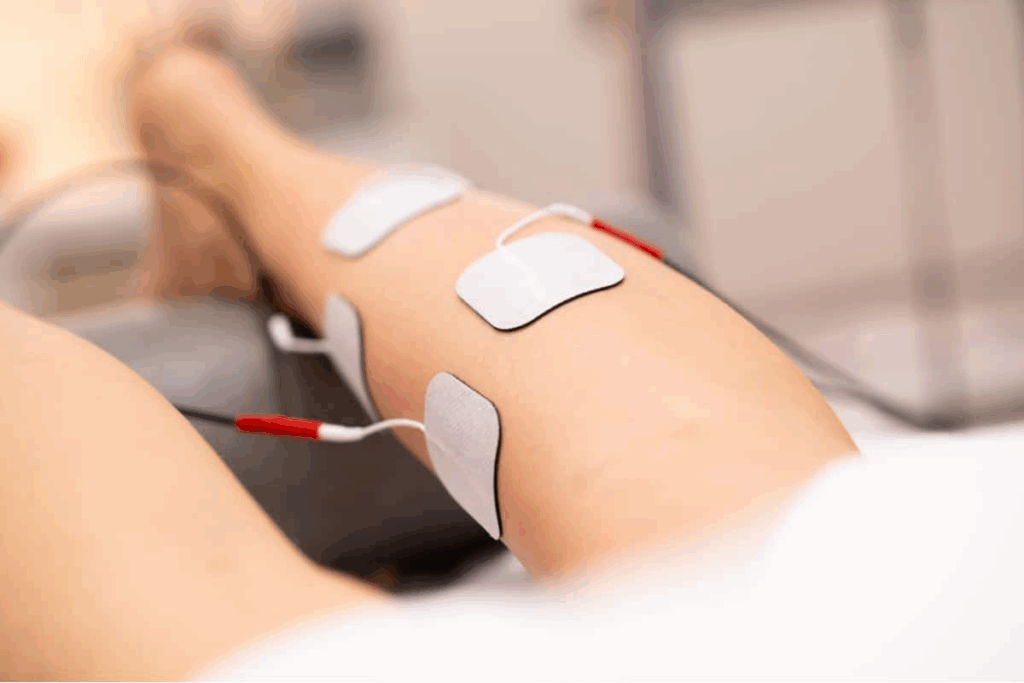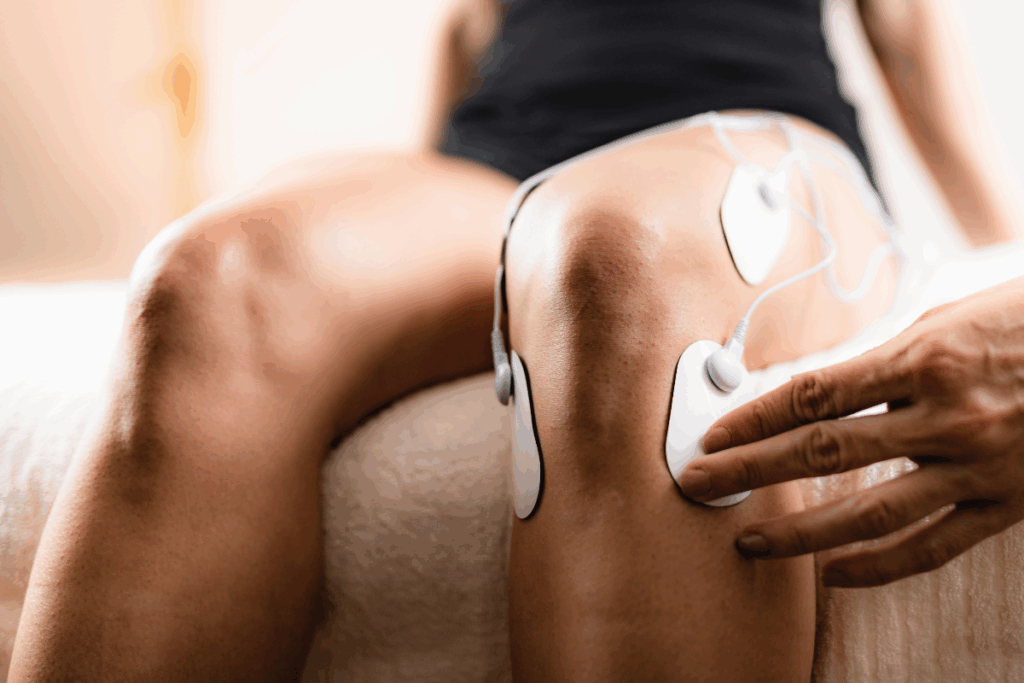
Living with back pain can really hurt your life. It affects not just your body but also your mood. At Liv Hospital, we’re here to help you feel better. Discover does a stent have to be replaced and when heart stent replacement is necessary.
Electrotherapy is a new way to treat back pain. It uses electrical currents to help with pain, swelling, and healing.
Our team uses the newest electrotherapy methods for back pain relief. In this article, we’ll look at seven ways electrotherapy can help. We’ll talk about how they work, their benefits, and when to use them.

Electrotherapy is a good way to handle back pain. But first, we need to know what back pain is. Back pain, when it lasts a long time, can really hurt your life. It makes it hard to do simple things and affects how you feel overall.
Chronic back pain is a tough problem. It can come from many things. Knowing what causes it helps find the best way to treat it.
Many things can cause chronic back pain. These include muscle strain, herniated discs, and spinal stenosis. Muscle strain happens when you use your back muscles too much or not right. This leads to pain and swelling. Herniated discs occur when the soft part of the disc leaks out, hurting nearby nerves. Spinal stenosis is when the spinal canal gets too narrow, pressing on nerves and causing pain.
Electrotherapy stops pain signals to the brain and helps heal. It uses electrical energy to make muscles and nerves work better. This reduces pain. Electrodes are placed on the body to target pain directly, giving relief without drugs or surgery.
Electrotherapy is good for back pain because it changes pain signals and helps the body heal. Knowing how it works helps people with chronic back pain choose the right treatment.

Electrotherapy is a medical treatment that uses electrical currents to help with back pain. It’s seen as a non-invasive option for managing pain. This makes it a valuable tool in the field of pain management.
Electrical stimulation sends impulses to certain body areas. These impulses can block pain signals to the brain, making pain less felt. It also helps by improving blood flow, reducing swelling, and relaxing muscles.
The science behind electrotherapy is based on its ability to change how the body responds to pain. By using electrical currents, it can alter the way pain signals are sent to the brain. This helps those with chronic back pain find relief.
Electrotherapy has a long history, dating back to ancient times. People used electrical discharges from fish to treat pain back then. Over time, the technology has greatly improved, leading to many different types of electrotherapy.
Today, electrotherapy includes various methods like Transcutaneous Electrical Nerve Stimulation (TENS), Interferential Therapy (IFT), and Percutaneous Electrical Nerve Stimulation (PENS). Each has its own use and benefits, meeting different patient needs.
| Electrotherapy Modality | Description | Primary Benefit |
| TENS | Transcutaneous Electrical Nerve Stimulation | Pain relief through nerve stimulation |
| IFT | Interferential Therapy | Deep tissue stimulation for pain relief |
| PENS | Percutaneous Electrical Nerve Stimulation | Combining acupuncture with electrical stimulation |
People with back pain can find relief with TENS, a non-invasive treatment. TENS units send low-voltage electrical currents to the body through electrodes on the skin. This helps block pain signals to the brain.
TENS therapy interrupts or blocks pain signals to the brain. The electrical impulses from the TENS unit applied to the affected area reduce pain. This is based on the gate control theory of pain.
For more detailed information on how TENS therapy can be used for back pain, you can visit WebMD’s resource on TENS for back, which provides detailed insights into its application and benefits.
To apply TENS therapy, place electrode pads on the skin near the pain area. Adjust the intensity and frequency of the electrical impulses based on comfort and pain severity. Sessions can last from 15 to 30 minutes and can be repeated several times a day as needed.
It’s important to follow the manufacturer’s instructions for the TENS unit. Also, consult with a healthcare professional to determine the most effective settings and application methods for your specific condition.
Many studies have shown TENS therapy’s effectiveness in managing chronic back pain. It offers pain relief, improved functional ability, and better quality of life. By reducing pain, individuals can participate more in physical therapy and daily activities, leading to overall well-being.
Key benefits of TENS therapy for back pain relief include:
By adding TENS therapy to a pain management plan, individuals with chronic back pain can see significant improvements in symptoms and quality of life.
Interferential Therapy (IFT) is a modern way to treat chronic back pain. It uses two high-frequency currents that meet inside the body. This creates a deeper and more comfortable effect than some other treatments.
IFT works by using two high-frequency currents that cross paths in the body. This creates an interferential current. This current goes deeper into the tissue, helping to heal and reduce pain more than a single current.
The benefits of IFT come from several sources:
TENS (Transcutaneous Electrical Nerve Stimulation) and IFT are both used to manage pain. But they differ in how they work. TENS uses a single current, which may not reach as deep as IFT’s interferential current.
Key differences include:
IFT is great for people with chronic back pain that hasn’t gotten better with other treatments. It’s also good for those who want a non-invasive option.
Ideal candidates may include:
Percutaneous Electrical Nerve Stimulation (PENS) is changing how we treat chronic back pain. It mixes old-school acupuncture with new electrical stimulation. This mix has shown great promise in helping those who haven’t found relief elsewhere.
PENS therapy blends acupuncture with electrical nerve stimulation. This blend creates a powerful effect that boosts pain relief. Fine needles are placed in certain spots and electrical impulses are sent through them. This method stimulates the body’s healing processes more effectively than either treatment alone.
The electrical stimulation in PENS boosts the effects of acupuncture. This can lead to more lasting pain relief. It’s very helpful for those with chronic back pain who haven’t found relief with other treatments.
PENS is great for chronic back pain because it can reach deep tissues and stimulate nerves. Studies have shown it can cut down pain and improve how well patients can move.
The tailored approach of PENS lets doctors adjust the treatment for each patient. They can change the electrical stimulation’s frequency and intensity. This makes PENS a flexible treatment option.
During a PENS treatment, fine needles are placed in the affected area, and electrical impulses are sent. Most patients find it comfortable, with only a little discomfort.
We suggest a series of treatments for the best results. The number and frequency of sessions depend on the patient’s condition and how they respond. Our healthcare team works with patients to create a treatment plan that meets their needs and goals.
NMES has become popular for strengthening back muscles. It uses electrical currents to make muscles contract. This helps improve muscle strength and function.
This method is great for people with chronic back pain. Their back muscles may be weak due to injury or disuse.
NMES is a key tool in rehabilitation. It helps strengthen muscles that are weak due to injury or disuse. By using NMES on back muscles, people can get better spinal support and less pain.
The electrical stimulation helps muscles contract. This can lead to stronger muscles over time. Research shows NMES is effective, even for those who can’t do regular exercises because of pain or mobility issues. For more info, check out scientific journals.
The treatment plans for NMES vary based on the individual’s needs and goals. Electrodes are placed on the skin over the muscles to be treated. The intensity and frequency of the electrical stimulation are adjusted for each patient.
A typical session lasts 15 to 30 minutes. Patients may need multiple sessions a week. The treatment can last from weeks to months, depending on the condition and progress.
NMES is useful in many rehabilitation areas, mainly for chronic back pain. It can:
Adding NMES to a rehabilitation program can lead to big improvements. Always talk to a healthcare professional to find the right treatment plan. This ensures NMES is used safely and effectively.
Microcurrent Electrical Neuromuscular Stimulation, or MENS, is a new way to fight back pain. It uses low-intensity electrical currents. This method is great for those looking for a soft, non-invasive treatment.
MENS therapy sends very low electrical currents, often too weak to feel. These currents help heal and lessen pain. They also reduce inflammation, improve tissue repair, and relax muscles.
By using these benefits, MENS can give a lot of relief to those with chronic back pain.
The microcurrent in MENS therapy boosts healing at the cellular level. This can cut down pain by fixing the root causes. Plus, it helps the body heal faster from injuries or strains.
MENS therapy can be done in clinics or at home. Clinics offer professional help and monitoring. Home devices are handy for regular use.
We’ll look at the good and bad of each to find the best fit for you.
We use galvanic stimulation to help patients with back pain. This method uses direct current to heal and lessen pain. It works well for both sudden and ongoing pain.
Galvanic stimulation is great for both sudden and ongoing pain. For sudden pain, it cuts down inflammation and aids in healing. For ongoing pain, it blocks pain signals to the brain, giving relief.
Benefits for Acute Pain: Reduces inflammation, promotes healing
Benefits for Chronic Pain: Provides long-term relief, improves quality of life
Direct current in galvanic stimulation cuts down inflammation. This is key for both sudden and ongoing pain. It not only eases pain but also tackles the root cause of discomfort.
When using galvanic stimulation, setting the right intensity and duration is key. These are adjusted based on the patient’s needs and condition. Healthcare providers must think about the pain’s severity, the patient’s tolerance, and any health issues.
| Treatment Parameter | Consideration | Clinical Implication |
| Intensity | Patient tolerance and sensitivity | Adjust to a level that is comfortable yet effective |
| Duration | Severity of pain and condition | Longer sessions may be needed for chronic conditions |
| Frequency | Patient response and progress | Regular sessions may be required for optimal results |
By adjusting these settings and considering each patient’s needs, healthcare providers can get the best results from galvanic stimulation.
Severe back pain can really hold you back. But, Spinal Cord Stimulation (SCS) is a promising treatment. It involves a device that sends electrical impulses to the spinal cord. This helps people with severe back pain feel a lot better.
The SCS device is placed under the skin. Electrodes are near the spinal cord. It’s set to send specific electrical signals. The aim is to block pain signals to the brain and replace them with a better feeling.
Not everyone can get SCS. First, there’s a detailed medical check. This includes looking at your medical history and current health. Then, a temporary SCS device is tried to see how you react.
Research shows SCS can help with pain for a long time. Many people see a big drop in pain and feel better overall. How well it works depends on why you have back pain, your health, and how well you follow up care.
| Outcome | Percentage of Patients |
| Significant Pain Relief | 60-80% |
| Improved Quality of Life | 70-90% |
Electrotherapy is a key tool in managing back pain. But how do different methods stack up in terms of results? It’s important to look at how each treatment works and what makes one better than another.
Choosing the right electrotherapy for back pain involves several key factors. The type and severity of back pain are critical. For example, Transcutaneous Electrical Nerve Stimulation (TENS) is good for long-term pain, while Galvanic Stimulation is better for sudden pain.
What the patient prefers and feels comfortable with is also important. Some like treatments they can do at home, like TENS. Others might need more intense treatments, like Percutaneous Electrical Nerve Stimulation (PENS), which needs a doctor’s help.
Using electrotherapy with other treatments can make a big difference. For example, adding it to physical therapy can make muscles stronger and more flexible. It also helps reduce pain.
When electrotherapy is paired with things like medicine, acupuncture, or chiropractic care, results get even better. This mix can tackle different parts of back pain, leading to lasting relief.
Healthcare providers can create tailored plans by considering these factors and mixing treatments. This way, they can help patients find the best way to manage their back pain.
Our understanding of pain and electrotherapy is getting better. This means we can help more people with back pain. New technologies are making these treatments better and easier to use.
Now, we’re moving towards treatments that are made just for you. This means less medicine and more effective pain relief. Doctors can now give patients better care, making their lives better.
The future of electrotherapy looks bright. Scientists are working hard to make treatments even better. We’ll see new ways to manage pain, helping people all over the world.
Electrotherapy is a treatment that uses electrical energy to heal and reduce pain. It sends controlled electrical currents to specific areas. This helps manage chronic back pain.
Yes, they are safe when done by a qualified healthcare professional. But, talk about any metal implants or pacemakers first.
There are many types, like TENS, IFT, PENS, NMES, MENS, Galvanic Stimulation, and SCS. Each has its own way of helping with back pain.
How often depends on the treatment, your pain level, and how you react. Your doctor will make a plan just for you.
Yes, it can be used with other treatments like physical therapy or medication. This can help manage pain better.
Effects last differently for everyone. It depends on the treatment, your pain, and your body’s response. Some may need ongoing treatments.
It’s not a permanent fix, but it can help manage chronic pain long-term. Regular treatments and lifestyle changes can keep pain away.
Some treatments, like TENS or MENS, can be used at home. But, others like PENS or SCS need a doctor’s office.
Your doctor will check your medical history and pain level. They’ll decide if electrotherapy is right for you.
Most people don’t have serious side effects. But, some might get skin irritation or muscle soreness. Talk to your doctor about any worries.
Subscribe to our e-newsletter to stay informed about the latest innovations in the world of health and exclusive offers!
WhatsApp us